Welcome to the website of author and artist, Stella Brians
Stella Brians is a New Englander who writes fiction, fantasy, and poetry. Brians is the author of The Hidden World of Wysteria Fantasy Series, with more fine books and art on the way. She was educated at Norwich Free Academy, a unique high school that focused on art and creativity. She loves animals, and her favorite kind of music is Shoegaze. Her favorite bands are My Bloody Valentine, The Cure, and The Beatles. She also loves Iron Maiden. A film fantanic, Stella adores indie films such as Paperhouse (1988), and anything directed by Dario Argento or Alfred Hitchcock. Her very favorite film is Harold and Maude (1971).
To Purchase Stella’s books in paperback or Kindle formats:
https://www.amazon.com/Stella-Brians/e/B01N3MEQ3Y
Currently, I am working on the third book in My Hidden World of Wysteria Series, titled Beneath Rain and Stars, along with two other book projects! Please stay tuned to learn more!
Official Beneath Rain and Stars Cover Art
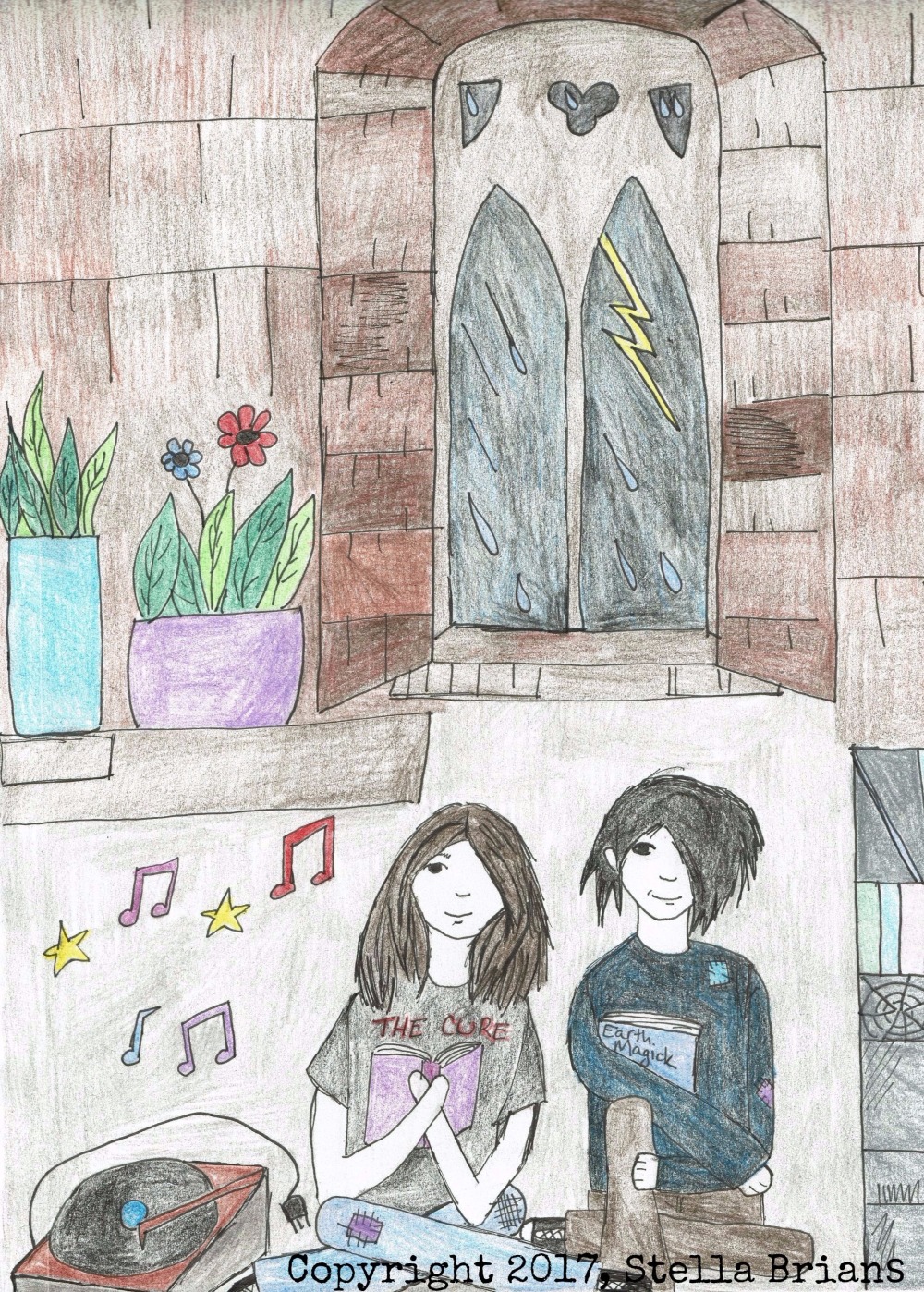
An article I wrote for The Visionary Fiction Alliance about my work and inspiration:
How I Became Inspired to Write a Visionary Fantasy Series – Stella Brians
By Guest Author | January 9, 2017 | Blog, Guest Posts
New England Inspiration
New England Inspiration
I grew up in Norwich, which is a little town in Connecticut rich in beauty and in history. Old buildings lined most streets, and are still used as existing businesses. The Norwich Post Office was built in 1905, in the Classical Revival design. I attended Norwich Free Academy, a high school mainly composed of very old and beautiful buildings. Perhaps the most notable is the Slater Museum. The museum has always kept a variety of different art pieces, but what always stuck out to me was the plaster cast collection of Egyptian, Greek, Roman, and Italian-Renaissance sculptures. I lived down the street from my school, which was very close to the Yantic Cemetery, and the Indian Leap Falls. The Yantic Cemetery was special, because it was built in the Victorian era, back when they used to design graveyards like gardens. Pathways, trees, and aesthetically pleasing graves were only a few of the lovely features. I would often come to the graveyard, to walk and have some time alone to think. Sometimes, I felt as though the tall trees could hear my thoughts. It is one of the most peaceful places I have ever been to, and there is something about it that does not make one fear death nearly as much.
Norwich is teeming with Native American history, is bordered on all sides by old buildings each with their own story, and natural beauty such as the Indian Leap Waterfall. The middle school I attended was formerly a Thermos Factory, and there was always something about New England rain that fascinated me.
How I Came To Write Visionary Fiction
New England has a very New Agey feel to it. Perhaps it is because of the Salem Witch Trials, or because it was the original and rightful home of many Native Americans. Whatever the reason is, I am very glad of it. When I was thirteen, I met an elderly woman who told me about past lives and spirit guides. We would visit and talk at length about these subjects. She told me that I was an Indigo Child, and a very old soul. I was already interested in Wicca and Creative Visualization, and had read several books on each. I do not identify with a specific religion, but I will explain to those who ask that I have New Age beliefs. Over the years of exploration and reading, I finally decided to write a Visionary Fantasy Series about old souls who die, and live together in an afterlife known as Wysteria. In the series, visualization, communication with the Universe, paganism, and old souls are discussed. I plan to go into these topics even further in my third book.
There have been many books written on Wicca, Meditation, Creative Visualization, and all sorts of Metaphysical topics. However, there seems to be a lack of fiction books exploring these New Age topics. Sometimes, people are unfamiliar with the wide-span of beliefs associated under the New Age umbrella. They may come from a very religious family, or just have never been introduced to it. Fiction is a great way to reach out to people, in a very gentle way. Rather than publishing a ‘How To’ book, I created a world that resembled the one I had lived and became comfortable in. As a child I was very withdrawn and quiet. I lived in my own world, created characters for it, and I loved to sketch and write. In my Hidden World of Wysteria Series, the main characters are misfits who are quiet and not apt to fit into society. They no longer feel a connection with the world, and look within themselves for answers.
About my Hidden World of Wysteria Series
The first book in my series, The Paperback Writer of Central Park, was originally supposed to be a short story about an impoverished young woman who lived in New York City. Several edits later, it became a love story between two old souls who did not fit into the world, but still wanted to help others. In the end of the book, they meet a kindly old wizard known only as Zeferaus who invites them into the afterlife dimension, Wysteria. What I like about writing Visionary Fantasy is that it allows me to intimately incorporate who I am, where I am from, and what I believe with an abstract leniency. My series is a safe space for myself, and for others who wish to learn more about reincarnation, spirit guides, paganism, and so on. It is so important to me that others who are different or are on their own spiritual journey feel a sense of comfort knowing that there is something out there, and that the author cares very much about them.
Another important element in my Hidden World of Wysteria Series is New England nature, and animals of all kinds. I plan to also go over tree spirits and communication, from what I have researched. In the series, the trees (particularly willows) are very wise, and often times the animals are a guide of some kind. Kindness, love, and understanding are dominant themes as they should be in all life and death, and in all spiritual and religious facets. The Universe is written into the series as the creator of everything, although some characters who are partial to pagan views mention the Goddess. It is important to note, that some ideas are fictionalized as the genre is fantasy. While there is much truth within my stories, I like to add an element of fiction to avoid sounding preachy, and to always encourage people to think for themselves. This is very important to me.
In November 2016, I self published The Paperback Writer of Central Park, and in December of that same year I released the next book in the series simply titled Wysteria. Currently, I am working on the third book which will continue to focus on spirituality, paganism, and tolerance.
***
My Art
My art can be found on Deviantart, where prints and more are available.
https://jwriter89.deviantart.com/gallery/
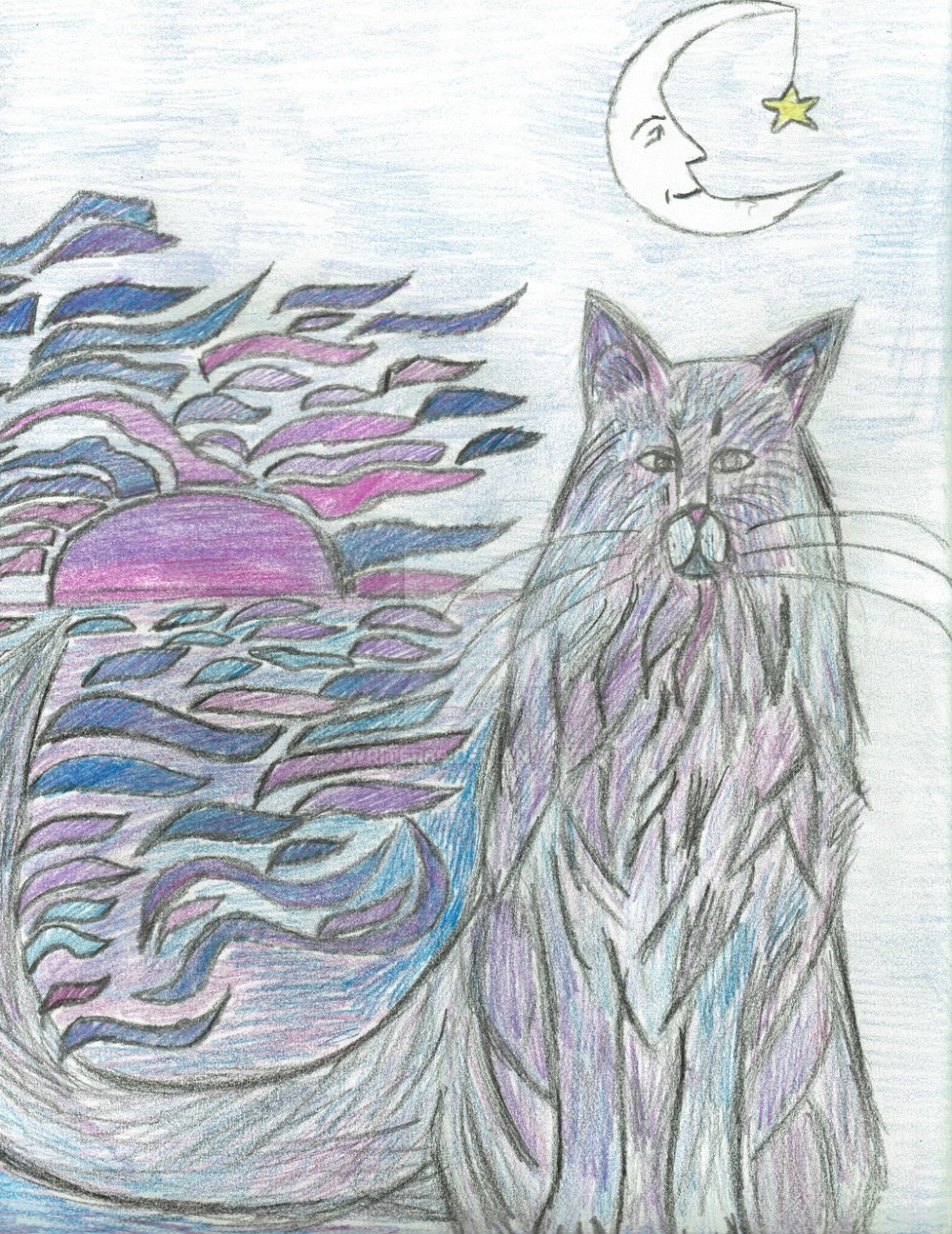
Improved Wysteria (Book 2#) Cover
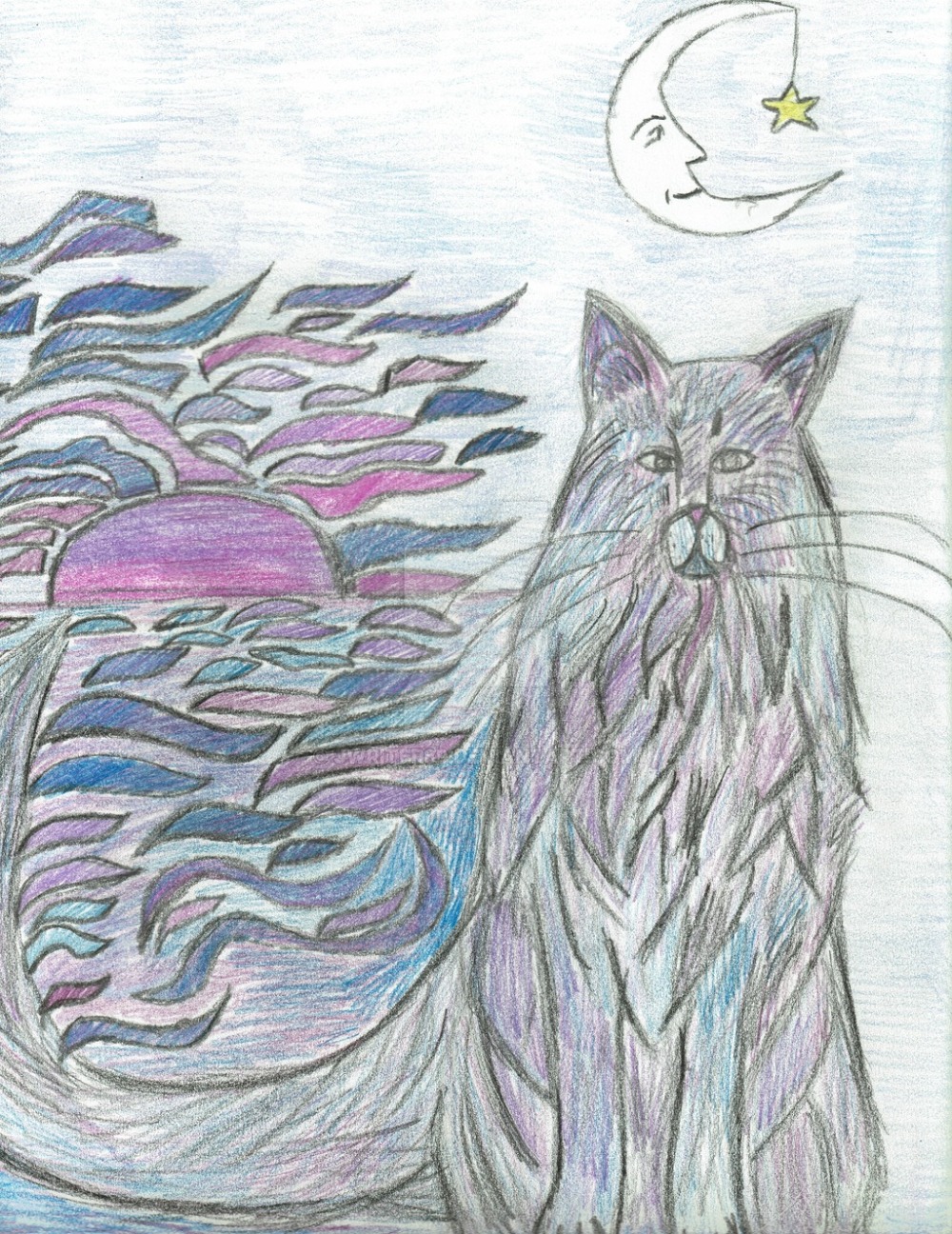
Here is the improved cover for my second book, which will be available again as soon as it passes through Createspace checks. This piece is one of my very favorites, and it depicts Rowan sitting by the Wysteria ocean at sunset.
Tools used to create this:
Colored pencils and imagination.
Interview With Lance and Brenda Eads of The Band Dandelion Root, and Regarding Lance’s Solo Music.
Interview With Lance and Brenda Eads of The Band Dandelion Root, and Regarding Lance’s Solo Music.
September 29th, 2017

Please Tell Me About The Music You Do as Lance Eads, and With Your Sons
Lance: Well, my wife Brenda and I have six kids. Our oldest son, Caleb, plays woodwinds and our second oldest, Isaac, plays percussion. I try to involve them whenever possible, though sometimes busy schedules make it difficult.

On one of my more recent albums, “Where the Branches Meet,” Caleb played flute on four of the seven songs. On one of those four songs Isaac played bongos. Originally it was going to be a nine song album and I was going to have Isaac doing some percussion on those other two songs and even have Caleb play bass guitar on one of them, but those pesky schedules got in the way. Maybe we’ll go back and add those last two songs one of these days.
On the album I just completed, “Botanical Theophany,” Caleb plays clarinet. Originally I was going to use harmonica on it, but Caleb asked if he could be on the album so I wrote him a short clarinet part and I think it turned out really well. He’s a freshman at the University of Portland right now and he’s majoring in music. Isaac is a sophomore in high school.

His solo albums can be found here: lance-eads.bandcamp.com/music
Tell me about Dandelion Root, the band which consists of you and your wife. Where can your albums be found?

Dandelion Root playing at a Block Party
Lance: Brenda and I have been singing songs together just for the fun of it pretty much since we first met back in ’94. It started to be less and less, though, the more kids we had and the busier our lives got. I guess that’s kind of how Dandelion Root started—as a way to make sure that we continue making music together.
Brenda: Our two youngest children play violin and cello and we’ve been starting to have them play music with us, too. The youngest plays violin and the second youngest plays cello. They joined us at a local farmer’s market playing a song and it sounded great!
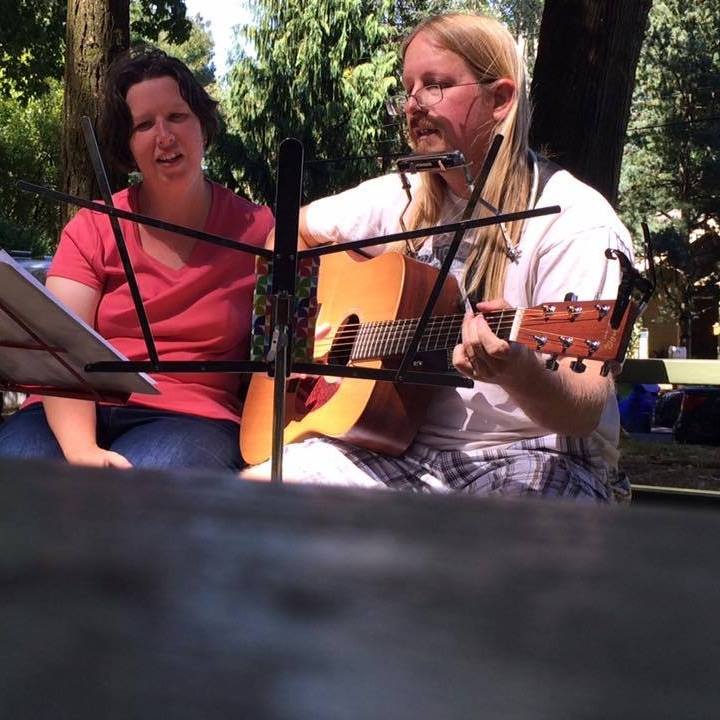
Dandelion Root at Columbia Park
Lance: We’re going to record that song with them soon. It’s “This Land is Your Land” by Woody Guthrie. With Dandelion Root we play coffee shops, sometimes bars,…the same kind of places I play on my own for the most part. Our albums can be found online at dandelionroot.bandcamp.com
What are your hobbies and interests?
Lance: Besides music, I enjoy drawing and painting, bike riding, and hand drumming. I’m not talking about drumming in a musical context, but more as a form of relaxation or meditation.
Brenda: Just singing and spending time with my family.
What inspires you as a musician?

Lance: I don’t remember a time when I didn’t want to be a musician. Growing up in the 70’s children’s shows on TV were filled with bands. There was Fat Albert, the Archies, the Groovy Ghoulies, The Monkees, and on and on. That influenced me, as did some of the popular music that I was aware of. My mom was a big Beatles fan, so even though they weren’t together anymore I heard a lot of their music early on.
In the 80s as a teenager I played drums, mostly in school band and in hard rock bands with my friends. It wasn’t until the 90s in college that I really started playing guitar and other instruments and writing music. At that time I was really drawn to the folk music of the 60s and also to the earlier music that influenced those artists.
I kind of consider music, visual art, writing, or really all art forms to be different ways of doing the same thing, which is expressing feelings, thoughts, ideas, and whatever’s close to your soul. I’ve always really loved drawing and painting and I consider music to be the aural equivalent of that. I can remember hearing “Yesterday” by the Beatles in the elevator at the mall when I was around five or six years old and thinking, “Wow, listen to the way the music and the words work together to paint a picture.”
What inspired your album, Botanical Theophany?
Lance: It’s interesting because most of the songs on this album were written about five years ago. My songwriting has slowed down recently, but for a long time I had notebooks full of songs that I didn’t know if I’d ever get to recording. Some of the songs on this album were ones that I skipped over many times in the past in favor of ones that I felt were better. But now that my cache of unrecorded songs is getting thinner I pulled them out and really I think the particular arrangements that I did instrumentally with these songs kind of brought them to life.
“Every Leaf” is a newer song. I was working on a Donovan song called “Deep Peace” and I really liked the chord progression. So I started singing a different melody to those same chords and that was the beginning of “Every Leaf.” The lyrics were influenced by current events with all the racism and prejudice in the news, but I don’t recall exactly how I chose the leaf metaphor.
“The Intelligence of the Dandelion Seed” is also somewhat new. It was inspired by a passage from an Alan Watts book. The “Unseen Garden” is also new. I don’t remember in particular what influenced it. I think I was just pondering some ideas from Indian philosophy about the nature of the universe and it became a song. The album was originally going to be called “The Journey of a Raindrop,” but I noticed how many of the songs used flowers and vegetation in their imagery so I changed it. The cover photo is from a park near our house.
Incidentally, the cover of “Where the Branches Meet” is also from close to home. It’s just a few miles from our house where the Willamette River and the Columbia River merge. That title, “Where the Branches Meet,” then, refers to the branches of the river, the branches of the tree in the foreground, the branches of different musical styles that I’ve tried to synthesize, and the meeting of this world with the spiritual world.
Theophany is a Greek word I learned in college. It basically means God or Divinity appearing in the physical world. So the idea behind “Botanical Theophany” is that the world of the sacred can be, and often is, experienced through the world of nature.
Please describe your song writing process.
Lance: Writing songs, like any art form, is kind of a mystery even to those who do it. Sometimes people ask me if I start with the words or with the music, but I don’t always do it the same way. I used to write lyrics even when I was a drummer and didn’t know how to write melodies or harmonies, so my earlier songs almost always started with the lyrics, but that’s changed over time. I still do it that way sometimes, but other times I start with a melody, or as is the case with “Every Leaf,” the harmonies or chords. But that question doesn’t get to the heart of what songwriting is. There’s some sort of a process that goes on in the mind where you combine all this disparate things—words, rhythm, melody, harmony, timbres—and come up with something strange and new. It’s like clothing a dream, or taking a sonogram of your soul.
I appreciate that you refer to my lyrics as poetic in your review. For some songwriters lyrics are just sounds to make with their voice to go with the other instruments, but I’ve always tried to actually say something worth hearing with my lyrics. I did go through a period where I was trying to write stream of consciousness lyrics–influenced by the beat poets, the surrealists, James Joyce, and Syd Barrett’s solo work—but I felt like even then the songs ended up having a message. The message was less consciously intentional and maybe less decipherable to people who didn’t know me, but it was still there. But some of my biggest influences have been people who are know for their lyrics as much as for their melodies; people like Bob Dylan, Neil Young, and Joni Mitchell.
I’ve dabbled in a lot of different styles over time. I’ve written and recorded straight ahead rock, jazz, blues, new age, experimental, but I feel like I really want to focus more now on songs that have the acoustic guitar and that western folk tradition at their center. I think it’s what I do best and probably what I enjoy the most. I still like rocking out with the electric guitar, but there’s just something about the intimacy and simplicity of one voice and one acoustic instrument. Of course, I still plan to do Dandelion Root and to collaborate with my kids and with other musicians, but I feel like maybe I’ve really found my own musical home from which to work—my own musical voice.
Is there anything else you would like to add?
Lance: Just thank you for doing this and for your wonderful review. I’ve been very happy with the response to this album so far and it makes me feel so good to know that people are enjoying these songs.
Brenda: Yes, thank you. Hopefully when and if things slow down a little bit, we’ll put out some new Dandelion Root recordings for people to hear.
Lance: You can bet on it!
Dandelion Root can be found playing at Farmers Markets, and occasionally coffee shops and bars in Oregon.
Album Review of Lance Eads’s Album Botanical Theophany

Album Review of Lance Eads’s Album Botanical Theophany
Review by Stella Brians
I love this album because of its gentle acoustic sound that is paired so pleasantly with hippie folk. The lyrics are poetic and positive, reminding us that we need to respect one another, work together in the world, and to be kind. This is an important message, now more than ever. Botanical Theophany gives us a reprieve from what is happening in the world today and gives the listener hope and peace. The sound of this particular album is hippie-folk with a dash of Cat Stevens. It is an album that sheds light in the places we need it to, reminding us that there are open minded people in the world who care and who want to share a powerful message that things will be okay. The mention of flowers in this album is frequent hence the title, reminding us that the Earth and Universe is still a beautiful magnificent place to be.
His album can be found here:
Protected: The Continued Adventures of Writer Cat
Book Review of Aria of The Sea
Book Review of Aria of The Sea by Dia Calhoun
Review By Stella Brians
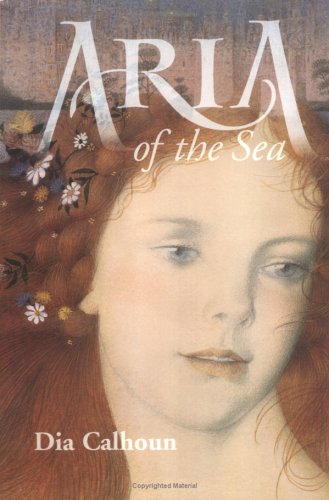
Several months ago, I found this book at a library book sale and was intrigued by the whimsical yet old fashioned cover art. It is beautiful hard bound book, and the particular copy that I have is pretty rare.
I meant to review this book back in July, but things became busy and hectic.
Aria of The Sea is a book about a girl of thirteen, Cerinthe. Cerinthe is reeling from the death of her mother, and wants very much to become a dancer (ballet) and to become educated at The School of The Royal Dancers in Windward. She has a great deal of trouble getting in, and when she thinks that she does not, she decides to work as a maid, or “smudge” for the dancing school.
Eventually, she is able to attend the school as a dancer, but a spoiled girl who also studies there called Elliana does not want her to feel welcome. Throughout the novel, Elliana tortures, belittles, and manipulates poor Cerinthe. Cerinthe has to deal with many emotions and troubles for a thirteen year old. She is homesick, and misses the seaside where she lived with her parents. Her father is a fisherman, and it seems to me that they do not have a close relationship. She wants very badly to do well as a dancer, and is always so exhausted. Her teachers are rarely friendly, and worst of all these things, she blames herself for her mother’s death.
In this poetic, dreamlike fantasy world that Dia Calhoun has created, young people have more freedom than they do in ours. Cerinthe attends the school completely alone, and without any (or very little, at least) contact with her father. She walks around the city alone. Another relationship Cerinthe is assaulted with, is with a boy around her age. His name is Thordon, and he works with ships in the harbor. He is not very nice, or interesting, despite his beautiful name. Thordon also turns out to be manipulative in the end.
Despite her missing her family and home, Cerinthe designs a beautiful dance which she called Aria of The Sea, in honor of her deity, The Sea Maid. She writes it so that she may hear The Sea Maid sing to her again, but nothing seems to be working. Anyway, Elliana ruins the dance, by taking it from Cerinthe and using it for disgraceful ends.
All of these events lead up to a very important choice that Cerinthe must make. She has the gift of healing, but she is not aware of this fact until she meets with a healer who insists that she should study with them instead.
But Cerithne loves dancing, and must make a choice, She must stop blaming herself for her mother’s untimely death, and at thirteen take the path that is truly right for her.
Dia Calhoun’s writing is very special, because she writes in her own very individual way that is gentle, whimsical, and very sincere. I truly felt that I was there at the ballet school, and amongst the waves of the ocean. I felt connected to the novel and to Cerinthe, and I think that anyone who has ever identified as different in some way will feel the same.
Aria of The Sea is a novel ideal for any age.
I now own and look forward to reading its sequel: The Phoenix Dance.
Protected: Getting Ready For Halloween
My Interview With Indie View
I found peace in New York City in a very ethereal way. Many of my feelings and memories about New York City during that time are kept in my novel as a sort of time capsule.
Stella Brians – 4 March 2017
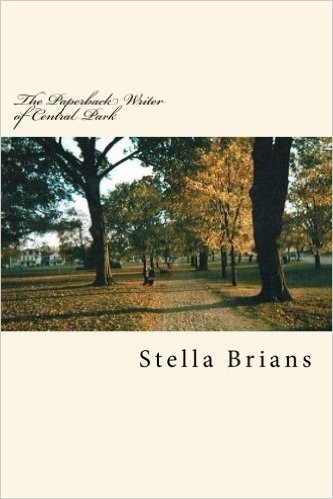
The Back Flap
Book One in The Hidden World of Wysteria Series
Elizabeth is homeless in New York City, sleeping in hostels when she can and barely surviving. Writing her novel keeps her going, and when it is published her life changes forever. Along with her Brit Punk friend Sarah, she starts a writer’s group for other indie writers. It is in that group that she meets River, a New Age hippie in whom she finds true love and a kindred spirit. The couple face both joy and tragedy in the city that never sleeps, before moving to a cottage in Mystic Connecticut to start a new life together. It is behind a bookcase in their attic that they discover the hidden world of Wysteria.
About the book
What is the book about?
The Paperback Writer of Central Park is about a young author who goes from being homeless in New York City to leading a group of indie authors towards their dreams. My book is also about her love and connection with River, a kindred spirit who relates to her when most of the world does not. It is about their friendship with British punk Sarah, and their shared love of New York City. My novel is also about nature, and their eventual discovery of Wysteria, a New Age afterlife. The Paperback Writer of Central Park is the first volume in my Hidden World of Wysteria Series.
When did you start writing the book?
I began writing The Paperback Writer of Central Park in 2015.
How long did it take you to write it?
It took about three drafts and a year and a half.
Where did you get the idea from?
In 2009, I took a trip to New York City and stayed for a while in hostels. It was a very freeing experience, and most of the time I stayed in the upper West side of Manhattan. I would spend my days writing in a journal, taking walks, and visiting the Saint John the Divine Cathedral. Aside from the enormous and striking cathedral, I will note three peculiarities that interest me to this day about the cathedral. A very unusual fountain known as The Peace Fountain sits to the side of the cathedral. It is sculpted to depict the conflicts of good and evil. Angelic white peacocks stroll the grounds, and beyond the fountain is a children’s garden. I mention this because of the spiritual and New Age content of the books in my Hidden World of Wysteria Series.
It found peace in New York City in a very ethereal way. Many of my feelings and memories about New York City during that time are kept in my novel as a sort of time capsule.
In my novel, the main character Elizabeth befriends a punk rocker from England. Her name is Sarah, and was the one character I based almost completely on fact.
We met in the first hostel I stayed at, and we became friends. What I remember most about her is that she loved the Sex Pistols, and this movie Suburbia (1983.) She was such a sweet and fun person to hang out with. We lost touch after awhile, but I hope to find her again someday.
Other elements of my life that inspired The Paperback Writer of Central Park was growing up in beautiful New England, and being enchanted by rain and the poetic side of nature. Many of my New Age beliefs also inspired the book as well.
Were there any parts of the book where you struggled?
I think I struggled most in the very early stages with the plot and characters. Originally, The Paperback Writer was supposed to be a short story.
What came easily?
Once I worked through and rewrote weak elements of the story, I decided to make it into a novel. From there, the rest fell into place. After that, it became the first novel in a Metaphysical Fantasy series.
Are your characters entirely fictitious or have you borrowed from real world people you know?
All of the characters are fictional except for Sarah. Many are inspired by real people, or people I have observed or met. When you are a writer, it is helpful to people watch and to get ideas that way.
We all know how important it is for writers to read. Are there any particular authors that have influenced how you write and, if so, how have they influenced you?
My father is an author as well, and he influenced how I write in the sense that I remember to constantly improve, and to write the truth with class. Other than that, I would say that Laura Whitcomb’s style heavily influenced me. I loved her romantic, dream like tone in A Certain Slant of Light.
Do you have a target reader?
My target audience is 15—100. There are adult elements in my novels, but they are written with a gentle whimsical tone that I feel would engage a wide range of readers.
About Writing
Do you have a writing process? If so can you please describe it?
I tend to jot down ideas in a notebook or on my computer, and from there I do character and plot sketches. I sketch my characters too, and try to get into the environment that surrounds them. However, I do not plan too much as I am a discovery writer.
Do you outline? If so, do you do so extensively or just chapter headings and a couple of sentences?
I outline briefly, just enough to know where I am going. I leave the rest to creativity.
Do you edit as you go or wait until you’ve finished?
I edit as I go, and once finished I print the manuscript out and edit it long-hand. I feel that it is more genuine that way, and it works well for my thinking process. I want to make my novels the best they can be.
Did you hire a professional editor?
I write, edit, design the cover, and any art that goes along with it.
Do you listen to music while you write? If yes, what gets the fingers tapping?
I love to listen to New Age music while I write, or soft rock. Notable albums that have helped me write are: Deep Breakfast by Ray Lynch, and Everyone Else is Doing it, So Why Can’t We? by The Cranberries.
About Publishing
Did you submit your work to Agents?
I sent The Paperback Writer of Central Park to a few, but I am passionate about self-publishing. I felt that due to the unique nature of my work and the integrity of it, self-publishing was right for me.
What made you decide to go Indie, whether self-publishing or with an indie publisher? Was it a particular event or a gradual process?
Deciding to self-publish was a gradual process, because I wanted to give traditional publishing a fair chance. As months went by, I did an enormous amount of research on the publishing world, and even did a college paper on self-publishing. Ultimately, I chose self-publishing because I could keep the rights to my work, and be as creative as I wanted to be. I am a very independent soul, and I would have trouble with a publisher stepping on my toes. It is important for me to create uninhibited, while producing honest work that I hope people will love as much as I do.
Did you get your book cover professionally done or did you do it yourself?
I always do my own covers, and the art is my own save for the photograph of the Avery Point Lighthouse that is on the cover of Wysteria (Volume Two in my series). That was taken by my mother, and she did a fantastic job.
The photograph on the cover of The Paperback Writer of Central Park was an old shot that I had taken from a disposable camera when I lived in Colchester, Connecticut. It worked perfectly for the book.
I am going a different creative route with the third book in the series, as I will be illustrating the cover and providing some interior drawings as well.
Do you have a marketing plan for the book or are you just winging it?
As a new indie author, I am discovering what works best, and what does not.
Any advice that you would like to give to other newbies considering becoming Indie authors?
I would like to suggest that you do as much research as you can. Taking writing workshops can be very helpful. Always make sure that you can keep the rights to your own work, and be as creative as you want to be. This is so important.
It is vital that you advocate for yourself as an indie author. Hang up flyers where you can, ask bookstores if they would be interested in selling your book, politely ask for interviews from online blogs and magazines. Always be creative, kind, and professional.
A website I suggest is Scribophile, it is a wonderfully supportive online writing group.
I would also like to suggest The Fiction Writer’s Handbook, by Anthony Maulucci. It is a very helpful guide that I have used in the past.
About You
Where did you grow up?
I grew up in Connecticut. I was born in Hartford, but my family moved to Norwich in the early nineties. Norwich is a historic little town, and has inspired my Hidden World of Wysteria Series on different levels. I am an alumnus of Norwich Free Academy in Connecticut.
What would you like readers to know about you?
I love to write, read, and sketch. Some of my favorite bands are The Beatles, Iron Maiden, My Chemical Romance, and The Cure. My favorite thing in the world is to spend time with my soulmate, Clint.
What are you working on now?
I am working on the third volume in my Hidden World of Wysteria Series.
For more from Stella, visit her website, her Tumblr page, or follow her on Twitter.
Get your copy of The Paperback Writer of Central Park from Amazon US or Amazon UK.